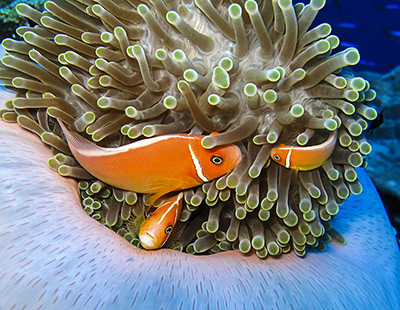
Anemone fish on an anemone Photo by Kosrae Nautilus Resort
If you’ve never heard of Kosrae, it’s not surprising.
It’s the easternmost of the 607 islands dotted across a million square miles of ocean that make up the Federated States of Micronesia (called simply, FSM). It truly is in the middle of nowhere....2,800 miles southwest of Hawaii, 1,500 miles east of Guam and a scant five degrees north of the Equator.
Though many islands in this part of the world are flat atolls, Kosrae (pronounced ko-shrye) has tall serrated mountains and looks like a mini Hawaii or Tahiti. It’s tiny, shaped like a triangle and barely 15 miles across at its widest. But it also has to compete with its better known cousins, Palau, Yap and Chuuk (formerly known as Truk).
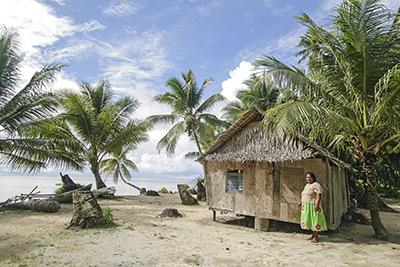
Local woman stands by her
palm thatch house in Walung,
an
isolated village in Kosrae, Federated States of Micronesia.
Photo by Yvette Cardozo
The very fact that most people miss Kosrae is why it’s special. Untouched. Unspoiled. The kind of place you say, “Gee, wish I had gone there 20 years ago,” except 20 years ago is now.
There’s a story dating back to WWII that says it all. Back at the end of the war, when the occupying Japanese force was ordered to kill the locals, the soldiers warned them instead, then mingled with them so nobody would consider shooting. Wander into someone’s yard and you risk being invited to dinner, or at least being showered with food to take home.
Heck, even the feral cats here are friendly.
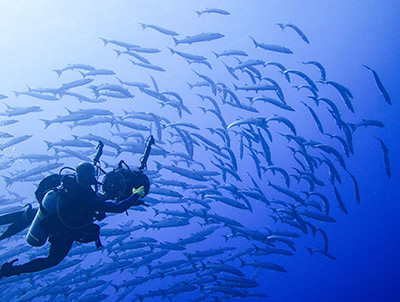
Diver and school of barracuda off Kosrae, FSM.
Photo by Katrina Adams
Kosrae is not easy to reachAdmittedly
...nine hours on the United island hopper jet from Hawaii. But remoteness is what preserves Kosrae's charm.
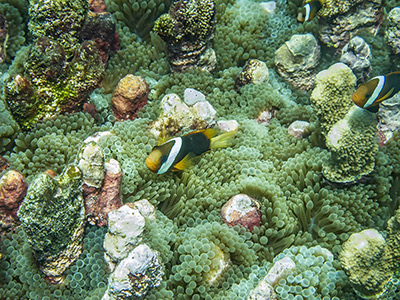
An example of how packed life is underwater in Kosrae.
Orange stripped anemonae fish, also called cinnamon or fire
clownfish, tiny fish that live in anemonaes in Kosrae's
shallow water. Photo by Yvette Cardozo
You don't come here to lie on the beach...frankly, there isn't much. And you don't come to do the latest pseudo adventure...no ziplines, no downhill bike rides. Or to shop...not a single craft shop on the island. What you do here is scuba dive, immerse yourself into the culture. And meet the locals.
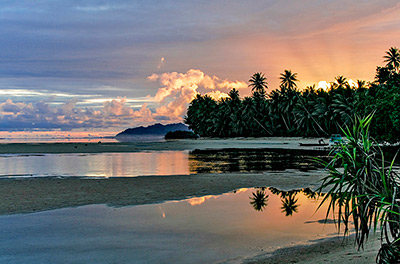
Dawn at Walung, isolated village on Kosrae
Photo by Yvette Cardozo
JET TO BOAT IN 30 MINUTES FLAT
Okay, you won’t be able to do this many other places, if any: Arrival jet to dive site in 30 minutes.
Customs took 20 seconds and a guy from Kosrae Village Ecolodge was waiting for me. We grabbed my hand luggage (only carry-on with mask and minimal gear...someone else picked up my suitcase) and took off for the dock.
Half an hour later, scuba gear on, I watched the jet that brought me take off for the next island. And I have the photos to prove it.
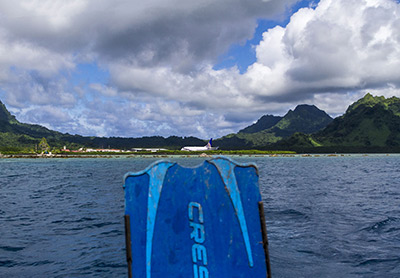
Jet sits on runway at Kosrae, Micronesia, taking off after
passengers disembarked. View is from dive boat with diver
who just arrived on that jet, getting ready for first dive on
Kosrae. That's the diver's fin in the foreground with the
departing jet in the background. Photo by Yvette Cardozo
THE CORAL GARDEN
Our plan one afternoon was to try and find some giant plates of coral I had seen growing among the roots of mangrove trees in Kosrae’s Utwe Biosphere Reserve. This is a massive protected mangrove and underwater park in Kosrae.
Coral growing among mangrove roots. Really? We absolutely had to go find it to dive, or at least snorkel.
On a rising tide, we carefully edged the Kosrae Village Ecolodge shallow draft catamaran through the shallows and began our search. Up and down we went, but no plates of coral.
However, by the mouth of a channel where tides bring swift currents and nutrients, we found a coral garden...finger, castle and boulder coral, all in miniature and swarming with hundreds, maybe thousands of fish of every imaginable type. There were chromis in three colors, squirrel fish, pipefish, batfish and giant oysters the size of softballs.
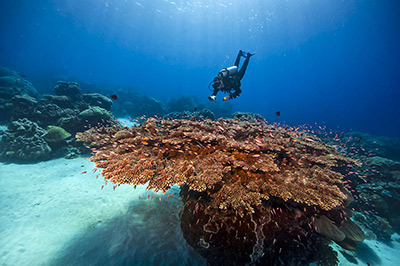
Diver inspects one of the many coral heads at Hiroshi Point.
Hundreds of anthias are swimming around the coral.
Photo by Tim Rock/Kosrae Nautilus Resort
I haven’t seen a spread like this since Irian Jaya, the other half of Papua New Guinea. It reminded me of the best of the Caribbean, circa 1970. All in barely three to five feet of water. A snorkeler’s paradise.
Honestly, I often think snorkelers get the short end of the stick, not being able to dive down to the really good stuff. But here, in shallow water, is a chance for non-divers to see what all the fuss is about.
We never did find those plates. But we stumbled on so much more.
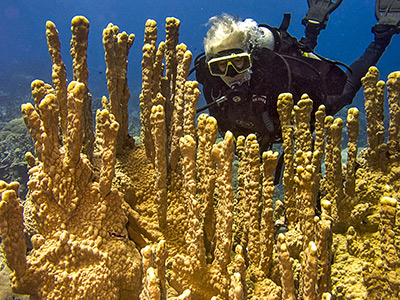
Woman diver floats over pillars of "castle coral" off Hiroshi
Point, Kosrae, FSM. Photo courtesy Kosrae Village Ecolodge
EAT LIKE A LOCAL
“The local women are out hunting slugs. Would you like to see?” an island friend asked me a day or two after I had arrived. Game to try just about anything that is not still moving, I figured, sure, why not?
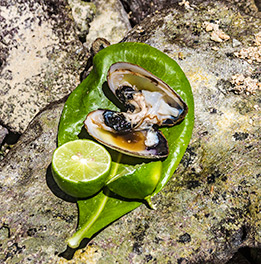
Clam that has just been dug up from wet
sand on low tide on Kosrae, Micronesia.
The raw clams are drizzled with lime and
quite tasty. The black part is edible.
Photo by Yvette Cardozo
It was low tide and the two inch deep water seemed to spread forever, studded with coral rocks that had been worn smooth by countless waves.
Louisa Musrasrik was already part way out to a rise where the coral rocks, when submerged, form a shallow reef. The islanders walk these reefs from the time they are toddlers, so she, at 66, was sure-footed.
By the time I caught up, she had already found half a dozen round, shallow, cone shaped critters that sure didn’t look like any slugs I knew. They were more like, well, I’m not sure, but they were vaguely familiar and could be pried from the rocks with your fingers.
“I cut them into tiny pieces and boil them for a long time. You need a crab, also. For flavor. Then I add coconut cream and a bit of salt,” Louisa said.
“Come back this afternoon and you can eat some.”
And five hours later, we did, indeed, return to a pot of creamy broth studded with tiny bits. They were a bit chewy but tender, a bit like bites of calamari and thoroughly infused with the flavor of the coconut.
Yum.
OTHER LOCAL FOODS
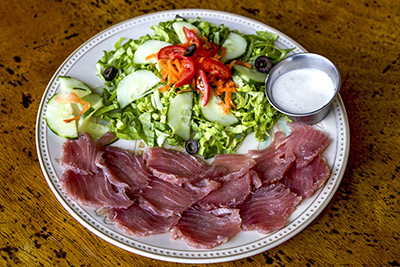
Yellowfin tuna sasami, fresh raw fish served with a green salad.
Photo by Yvette Cardozo
If you want it fresh and local here, forget anything except stuff from the sea. All other meats...beef, pork, chicken...are imported from the US.
So in my search for tidbits barely out of the ocean, I ate clams on the half shell, sponge innards, crab and, of course, fish.
I found Kenye Ismael and her sister sitting on a huge, horizontal mangrove tree root, digging in the wet sand at the edge of the shore one morning. Just inches down, there were dozens of clams the size of ping pong balls. Kenye would unearth one, wash it with fresh water, slit it open with her knife and squeeze on a bit of lime juice.
“That black stuff,” she said, pointing to a black collar on the raw meat, “is good for your stomach. It’s okay to eat.”
And so we did. The clams were tender, slightly sweet and slightly salty, with a hint of the sea.

Local man holds string of fish he caught
while snorkeling. Photo by Yvette Cardozo
From here, I went to meet Ruth Skilling, who was calf deep in water under a concrete causeway dock sifting through eel grass for sponges, a local delicacy. The sponges...palm sized, knotted tubular things...were everywhere.
Ruth split one open with a knife and deftly pulled out the beige innards, which we doused with lime so we could eat it on the spot.
The small ones are salty with a sharp aftertaste that lingers on the sides of your tongue. The large ones are definitely fishy...a bit like sea urchin roe. As for the fish, of course, I had tuna sashimi every chance I could get.
But the best meal I had all week was something that looked to me a bit like yellowtail snapper and is what locals call rabbitfish. It had just been caught in a net. The cook at Kosrae Village Ecolodge pan fried it and served it with slices of lime.
Double, no triple yum.
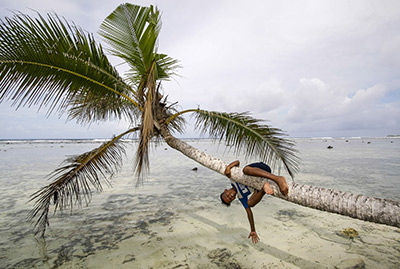
Local boy plays on palm trees on beach of Kosrae
Photo by Yvette Cardozo
WHAT IS THAT FURRY THING IN THE FRIDGE?
Well, most folks would recognize the husked coconut in the refrigerator of their cottage at Kosrae Village Ecolodge.
But over the years, enough people have asked, some slightly alarmed, that Katrina Adams and Bruce Brandt, owners of KVR, as the locals call the resort, have devoted an entire page in their welcome booklet to coconut knowledge.
That furry thing?
It’s a “drinking coconut.”
Coconut water, it turns out, is the Pacific’s answer to Gatorade. It’s full of electrolytes, digests easily and actually can be better for you than plain water if you need to replenish your minerals.
Inside the young coconut is the nearly clear “water” which, left to mature, will turn into the white coconut meat that people know.
On Kosrae, most young coconuts are gold. Inside is the hairy husk which the locals can chop away in what seems seconds but is way harder to do than it looks.
Once you get the hair off, you find three eyes. Puncture one, insert a straw and you are good to go.
And if you are lucky, the young coconut will also have a thin layer of meat that is soft and makes a great snack.
More coconut lore?
I grew up in South Florida eating coconuts and never knew about srimite, otherwise known as coconut endosperm.
It’s to a developing coconut what a yolk is to a growing baby chick...the source of nourishment for the young, growing plant.

Local children play in shallow water with traditional, hand carved
outrigger canoe off Walung, an isolated village in Kosrae
Photo by Yvette Cardozo
INFO BOX
There are three hotels used by tourists on Kosrae. All three have dive shops that offer dive packages, scuba equipment and nitrox:
*Kosrae Village Ecolodge & Dive Resort (KVR) with its nine traditional style bamboo and palm thatch bungalows just feet from the crashing surf, that have electricity and hot water but no air conditioning (except for one cottage) or telephones. www.kosraevillage.com
* Pacific Treelodge Resort, with six rooms that have air conditioning. This sits at the edge of one of the most picturesque mangrove swamps of Kosrae with a boardwalk through the mangrove and an open air restaurant over a river. www.divekosrae.com/resort/
* Kosrae Nautilus Resort, with air conditioned restaurant and 18 rooms that have air conditioning, TV and telephone plus internet access. It also has a swimming pool and is across the street from a beach. http://kosraenautilus.com/
Car rentals are available and there is an internet cafe on island. The island uses US currency and US electrical outlets. Average air temperature is 85 degrees but with extremely high humidity.
Average water temperature is in the low 80s year round. The trade winds blow November to mid June, bringing cool breezes but limiting scuba diving. Summer (July - Sept.) brings calm water, little wind and the best conditions for diving.
United is the only airline serving Kosrae, via an island hopper from Guam or Hawaii, (www.continental.com ) two days a week each way.
For general information, contact Kosrae Office of Tourism, www.kosrae.com .
|